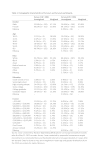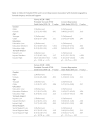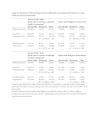2011 Joplin, Missouri Tornado Experience, Mental Health Reactions, and Service Utilization: Cross-Sectional Assessments at Approximately 6 Months and 2.5 Years Post-Event
- PMID: 26579331
- PMCID: PMC4639320
- DOI: 10.1371/currents.dis.18ca227647291525ce3415bec1406aa5
2011 Joplin, Missouri Tornado Experience, Mental Health Reactions, and Service Utilization: Cross-Sectional Assessments at Approximately 6 Months and 2.5 Years Post-Event
Abstract
Introduction. On May 22, 2011 the deadliest tornado in the United States since 1947 struck Joplin, Missouri killing 161 people, injuring approximately 1,150 individuals, and causing approximately $2.8 billion in economic losses. Methods. This study examined the mental health effects of this event through a random digit dialing sample (N = 380) of Joplin adults at approximately 6 months post-disaster (Survey 1) and a purposive convenience sample (N = 438) of Joplin adults at approximately 2.5 years post-disaster (Survey 2). For both surveys we assessed tornado experience, posttraumatic stress, depression, mental health service utilization, and sociodemographics. For Survey 2 we also assessed social support and parent report of child strengths and difficulties. Results. Probable PTSD relevance was 12.63% at Survey 1 and 26.74% at Survey 2, while current depression prevalence was 20.82% at Survey 1 and 13.33% at Survey 2. Less education and more tornado experience was generally related to greater likelihood of experiencing probable PTSD and current depression for both surveys. Men and younger participants were more likely to report current depression at Survey 1. Low levels of social support (assessed only at Survey 2) were related to more probable PTSD and current depression. For both surveys, we observed low rates of mental health service utilization, and these rates were also low for participants reporting probable PTSD and current depression. At Survey 2 we assessed parent report of child (ages 4 to 17) strengths and difficulties and found that child difficulties were more frequent for younger children (ages 4 to 10) than older children (ages 11 to 17), and that parents reporting probable PTSD reported a greater frequency of children with borderline or abnormal difficulties. Discussion. Overall our results indicate that long-term (multi-year) community disaster mental health monitoring, assessment, referral, outreach, and services are needed following a major disaster like the 2011 Joplin tornado.
Figures






Similar articles
-
Working after a tornado: a survey of hospital personnel in Joplin, Missouri.Biosecur Bioterror. 2014 Jul-Aug;12(4):190-200. doi: 10.1089/bsp.2014.0010. Epub 2014 Jul 11. Biosecur Bioterror. 2014. PMID: 25014654
-
Prevalence and predictors of PTSD and depression among adolescent victims of the Spring 2011 tornado outbreak.J Child Psychol Psychiatry. 2014 Sep;55(9):1047-55. doi: 10.1111/jcpp.12220. Epub 2014 Feb 28. J Child Psychol Psychiatry. 2014. PMID: 24580551 Free PMC article.
-
Predictors of compliance with tornado warnings issued in Joplin, Missouri, in 2011.Disasters. 2015 Jan;39(1):108-24. doi: 10.1111/disa.12087. Epub 2014 Sep 18. Disasters. 2015. PMID: 25231410
-
Prior Interpersonal Violence Exposure and Experiences During and After a Disaster as Predictors of Posttraumatic Stress Disorder and Depression Among Adolescent Victims of the Spring 2011 Tornadoes.J Interpers Violence. 2020 Nov;35(23-24):5179-5197. doi: 10.1177/0886260517719540. Epub 2017 Jul 20. J Interpers Violence. 2020. PMID: 29294844 Free PMC article.
-
[Posttraumatic stress disorder (PTSD) as a consequence of the interaction between an individual genetic susceptibility, a traumatogenic event and a social context].Encephale. 2012 Oct;38(5):373-80. doi: 10.1016/j.encep.2011.12.003. Epub 2012 Jan 24. Encephale. 2012. PMID: 23062450 Review. French.
Cited by
-
Public Disaster Communication and Child and Family Disaster Mental Health: a Review of Theoretical Frameworks and Empirical Evidence.Curr Psychiatry Rep. 2016 Jun;18(6):54. doi: 10.1007/s11920-016-0690-5. Curr Psychiatry Rep. 2016. PMID: 27086315 Review.
-
Mental health trajectories of individuals and families following the COVID-19 pandemic: Study protocol of a longitudinal investigation and prevention program.Ment Health Prev. 2021 Dec;24:200221. doi: 10.1016/j.mhp.2021.200221. Epub 2021 Sep 30. Ment Health Prev. 2021. PMID: 34608431 Free PMC article.
-
Utilization of Mental Health Support Systems in the Aftermath of Disasters in Japan: Statistical Data of the Miyagi Disaster Mental Health Care Center.Int J Environ Res Public Health. 2022 Aug 31;19(17):10856. doi: 10.3390/ijerph191710856. Int J Environ Res Public Health. 2022. PMID: 36078569 Free PMC article.
-
Mental Health Impacts of Tornadoes: A Systematic Review.Int J Environ Res Public Health. 2022 Oct 22;19(21):13747. doi: 10.3390/ijerph192113747. Int J Environ Res Public Health. 2022. PMID: 36360627 Free PMC article.
-
The Relationship Between Posttraumatic Cognitive Change, Posttraumatic Stress Disorder, and Posttraumatic Growth Among Chinese Adolescents After the Yancheng Tornado: The Mediating Effect of Rumination.Front Psychol. 2018 Apr 9;9:474. doi: 10.3389/fpsyg.2018.00474. eCollection 2018. Front Psychol. 2018. PMID: 29686638 Free PMC article.
References
-
- National Weather Service. NWS Central Region Service Assessment: Joplin, Missouri, Tornado – May 22, 2011. July 2011
-
- Paul B, Stimers M. Exploring probable reasons for record fatalities: the case of 2011 Joplin, Missouri, Tornado. Nat Hazards. 2012;64(2):1511-26.
-
- Houston JB, Franken NJ. Disaster Interpersonal Communication and Posttraumatic Stress Following the 2011 Joplin, Missouri, Tornado. Journal of Loss and Trauma. 2013:1-12.
-
- Letner, J. ‘A Fist Coming Out Of The Sky’: Six Miles of Terror. The Joplin Globe. 29 May 2011.
-
- Associated Press. Damage from Joplin, Mo., Tornado: $2.8 Billion. SF Gate. 20 May 2012.
LinkOut - more resources
Full Text Sources

